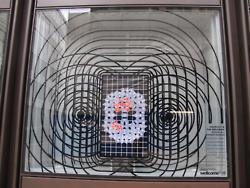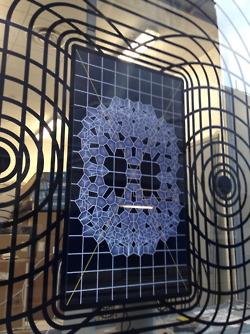Anarchy in the Organism: Challenging perceptions of cancer through art
Submitting Institution
University of HertfordshireUnit of Assessment
Art and Design: History, Practice and TheorySummary Impact Type
SocietalResearch Subject Area(s)
Mathematical Sciences: Statistics
Medical and Health Sciences: Neurosciences
Psychology and Cognitive Sciences: Psychology
Summary of the impact
Professor Simeon Nelson's research into cancer from multiple perspectives
led to the creation of a site-specific artwork, Anarchy in the
Organism, a genuinely successful interdisciplinary project in which
oncology, visual art, music, computer science, psychology and sociology
came into enriching interaction. His artist's residency at University
College Hospital London (2011—12) revolved around cancer patients and the
fact of cancer, and was informed by patient-led discussions and
interactions with carers, families, doctors, nurses, psychologists and
research scientists. This consultative process, and the resulting public
art installation, radically altered patient and clinician perceptions of
the disease.
Underpinning research
Anarchy in the Organism was a commissioned work arising from a
Wellcome Trust-funded residency at University College Hospital London.
Awarded to Professor Simeon Nelson through a competitive process, the
initial stages of the project began in 2010. The artist's residency ran
from April 2011 to April 2012, and a publicly displayed art installation
was in place from the end of the residency until the end of May 2013. The
artwork, consisting of four 55-inch video screens embedded in a geometric
pattern displaying abstracted organisms, was installed in the street-
facing windows of the newly opened Macmillan Cancer Centre on Capper
Street, London, the most advanced cancer centre in the UK.
Complexity theory, an integrative way of understanding whole systems and
their parts, underpinned the thinking behind Anarchy in the Organism.
The theory describes a reality that is non-deterministic: the future
cannot be predicted, there is no linear causality, and indeterminacy,
chance and choice are intrinsic to being in the world. Nelson used this
theoretical approach as a way of discerning underlying similarities in
disparate phenomena to confront the possible meanings of cancer from
scientific, social, cultural, ethical and existential perspectives.
The resulting art installation was informed by current research into
cancer as a complex system, particularly the work of UCHL's biomedical
imaging centre. Nelson entered into collaborative conversations with
research and clinical staff as well as one-to-one, patient-led interviews
in his studio, as a method of understanding the subjective experience of
the disease. During these latter sessions, he asked patients to reflect on
what the disease meant to them, if it had altered their perceptions of
their own bodies, whether it had caused a shift in their understanding of
what it meant to be alive, and how they visualised cancer.

The actual making of the artwork followed these conversations. Simon
Walker-Samuel, consulting scientist at UCL, created a series of algorithms
that generated a random depiction of cell growth, which in turn would
sometimes mutate, mimicking and depicting the development of cancer. Sited
in the Cancer Centre's street-facing windows on Capper Street, the Anarchy
in the Organism installation is a synthesis of algorithmic video and
applied pattern, linking it to its architectural context and transmitting
ideation of cancer as a complex system, situating the disease within a
wider context of intricate, evolving systems, from cities to trees to
landscapes.

His interactions with staff, patients and others played a vital part in
Nelson's creation of a work that attempted to reconcile cancer as a
normative part of being in the world. The computer-generated organisms,
shifting and changing on the four screens of the Capper Street
installation, demonstrated growth, mutation and decay as normal aspects of
being alive. Accompanied by a haunting soundscape composed by Rob Godman
and projected through window-mounted transducers, the organisms endlessly
transmuted, developing cancer to varying degrees. Coded within the
parameters of complexity theory, their survival rate is similar to that of
the general population.
References to the research
Public Artwork
Anarchy in the Organism. Computer-generated sound and video
installation, Macmillan cancer hospital, Capper Street, London, 15 April
2012 to 31 May 2013. Coding by Nick Rothwell, music by Rob Godman.
— REF2 Output
Publication
Nelson, Simeon (ed.), Anarchy in the Organism (London: Black Dog
publishing, 2013). ISBN 9781908966285
Nelson, Simeon: `Cancer and Complexity in an Unfolding World', in Simeon
Nelson (ed.), Anarchy in the Organism (2013), pp. 24—36.
Symposium
`Anarchy in the Organism: Cancer as a Complex System', Wellcome
Collection Conference Centre, London, 15 June 2012.
Funding
UCLH Arts was awarded £30,000 for the residency (Wellcome Trust
Arts Award, April 2011—April 2012).
Details of the impact
Dissemination
Nelson's 2011—12 residency included several presentations within and
outside the hospital. A public symposium was held during the London
Creativity and Wellbeing week in 2012, at which around sixty project
collaborators, patients, members of the public, clinicians and scientists
shared ideas about the science and art of cancer. A Huffington Post
video of the installation has received over 1,500 views since being posted
online in April 2012, further spreading awareness of the work, and the
installation has been booked for the Kings Place Festival (London) in
January 2014.
Reach
The work's siting, facing onto a busy street just off London's Tottenham
Court Road, made it accessible to hospital visitors and passersby. An
independent market research survey carried out in May 2013 counted, during
a six-day (28½ hours) observation period, 5,295 passersby (average: 185
per hour). An estimated 15% of them actively looked at the artwork, and
60% of the 88 people surveyed confirmed that they used the route regularly
and had viewed it before. Although located at a single site, the artwork's
reach over the 14-month display period was therefore considerable. Two
hundred patients, staff and others completed a questionnaire in the same
month. As the installation faced outwards rather than into the cancer
centre, the percentage of this group who had previously seen the artwork
was lower, at 12%.
Significance and Impact
The Public
A month after its unveiling in 2012, a Huffington Post reporter
witnessed the work `confounding and delighting passersby', and noted that
`the reactions to the piece vary from none, to confusion and long,
drawn-out stares'. The questionnaire gave depth to these responses: 80% of
members of the public surveyed said the artwork was good for the centre
(5% said not; the remainder were unsure). The majority offered positive
impressions, saying, for example, that `the visual aspect of cancer is
good', `I like that it communicates cancer in a new way', and `All art is
good art in hospital. . . This piece is very stimulating.' Some would have
liked more explanation, or thought it `too abstract', but others rose to
its challenge, stating: `The abstract nature of the piece really appeals
to me. This challenges my view of cancer', and `I like the way the artwork
deals with such a taboo subject in a straightforward way.'
Cancer Centre Patients, Carers, Staff and Visitors
The majority (44%) of the 167 patients, staff and others who were
interviewed in person were patients; a further 23 staff completed the
survey by email. Again, most (73%) thought it was a good artwork for the
cancer centre; the 15% who disagreed found the reminder of cancer
`unwelcome' or `comfortable', preferring `something to distract rather
than highlight cancer'.
Even those hostile to the work engaged even more fully with it than the
public viewers. Many offered thoughtful, outspoken or animated opinions:
one was `shocked by the piece', thought it `could attract controversy',
and `didn't wish to see cancer as a glamorisation', but conceded `[I] can
see how it helps non cancer patients understand cancer.' Several talked of
its lifting a `taboo', one noting that `relatives used to talk about it in
hushed tones so anything that changes people's perception of cancer is
good'. Another said: `Anything that highlights the reality of cancer and
explains cancer is a good thing, we've swept cancer under the rug over the
years.' Yet another praised `the idea that cancer is an aberration', and
especially liked `the audio component relating to the composer's relatives
last breath being incorporated into the piece'.
Additionally, the patient-informants who had informed the work's creation
reported that the residency, and their contribution to it, gave them a
voice, counteracting feelings of disenfranchisment during their treatment.
Senior professionals at the centre were very positive. Writing for the Anarchy
in the Organism (2013) publication, Simon Walker-Samuel said that,
as a research scientist, his conception of cancer had been enriched by
working on cancer at an abstract level of mathematics and aesthetics, and
by encountering the patient perspective. This was echoed by survey
participants, with one calling it `a very challenging piece . . . I think
that it is highly successful'. Another reported that patient feedback
about the artwork `is that it is highly valued . . . I think it could be
described as the bravest work'. Understanding the patient perspective was
important for yet another: `It brought me close to working with patients
who were suffering with cancer and . . . in terms of my emotional
understanding I think it definitely assisted with that'.
Artworld and Other Professionals
Six influential people involved in the commission were also interviewed:
[text removed for publication]
All spoke of the work's importance in terms of provoking dialogue, its
head-on engagement with uncomfortable subject matter, `opening up the
territory', and its `profound effect' on those involved in its
realisation. One said that, in artistic terms, it was `a model of
intelligent collaboration'. [text removed for publication] was
particularly supportive:
One of the things we find about people with cancer is that if in their
mind the cancer is some horrible, evil-smelling, pussy fault caused by
them . . . then it is an awful feeling to live with . . . If they
understand that it is something that is part of them and that it is a
fault that has happened in terms of accumulation of growth, then it is
still killing them and it is still painful and it is still a horrible
thing to do, but the feeling is different. . . that is why I feel this art
does something for them.
Sources to corroborate the impact
Project Website and Blog
Website: <http://anarchyintheorganism.tumblr.com/>
— Includes links to (anonymised) patient interviews
Blog: <http://blogs.herts.ac.uk/research/2011/07/26/artist-to-portray-cancer-in-a-new-way/>
Report
Alistair Nicoll, `Anarchy in the Organism: Impact Report', August 2013,
market research report commissioned by the University of Hertfordshire.
Media Coverage
Melanie Hick, `Simeon Nelson's Anarchy In The Organism: Digital Cancer
Art At UCL Hospital: WATCH', 2 May 2012, Huffington Post:
<www.huffingtonpost.co.uk/2012/05/02/simeon-nelson-anarchy-in-the-organism_n_1471009.html>
Huffington Post video (interview and discussion with Simeon Nelson
about Anarchy in the Organism), April 2012:
<http://on.aol.com/video/anarchy-in-the-organism-artwork-at-london-cancer-hospital-517348841>
Simeon Nelson, Interview, BBC Three Counties Breakfast Show,
Friday 29 July 2012.
Other Corroboration
Gilly Angell, `A View from the Other Side: A Patient Perspective', in
Simeon Nelson (ed.), Anarchy in the Organism (2013), pp. 18-23.
Anarchy in the Organisation public symposium, London Creativity and
Wellbeing week, 13-20 June 2012:
<www.creativityandwellbeing.org.uk/week/events/anarchy-organism-aito-cancer-complex-system>
Kings Place Festival, London, January 2014:
<www.kingsplace.co.uk/whats-on-book-tickets/music/anarchy-in-the-organism#.UlbYbRBRGdk>